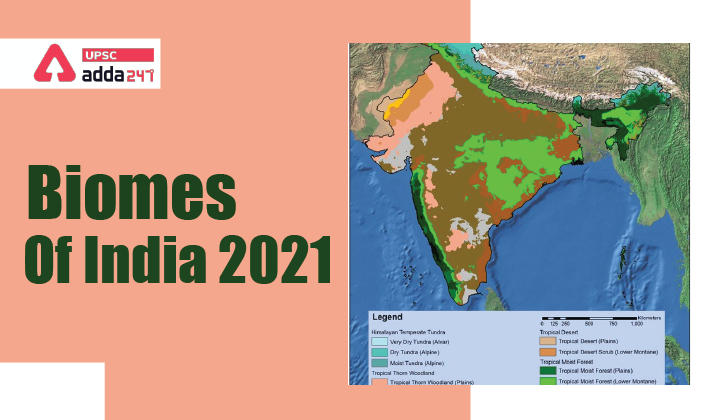Table of Contents
Biomes in India: Relevance
- GS 3: Conservation, environmental pollution and degradation, environmental impact assessment.
Biome meaning
- A biome is a large community of vegetation and wildlife adapted to a specific climate.
- There are five major types of biomes: aquatic, grassland, forest, desert, and tundra.
- However, some of the above biomes can be further divided into more specific categories, such as freshwater, marine, savanna, tropical rainforest, temperate rainforest, and taiga.
Biomes in India
Biomes in India can be broadly classified in the following five categories:
- Tropical Evergreen and Semi-Evergreen forests
- Tropical Deciduous forests
- Tropical Thorn forests
- Montane forests
- Littoral and Swamp forests.
Tropical Evergreen and Semi-Evergreen forests
Location
- Tropical Evergreen forests are found in the western slope of the Western Ghats, hills of the north eastern region and the Andaman and Nicobar Islands.
- They are found in warm and humid areas with an annual precipitation of over 200 cm and mean annual temperature above 22 C.
Characteristics
- Tropical evergreen forests are well stratified, with layers closer to the ground and are covered with shrubs and creepers, with short structured trees followed by tall variety of trees.
- In these forests, trees reach great heights up to 60 m or above.
- There is no definite time for trees to shed their leaves, flowering and fruition. As such these forests appear green all the year round.
Species
- Species found in these forests include rosewood, mahogony, aini, ebony, etc
Semi evergreen forests
Location
- The semi evergreen forests are found in the less rainy parts of these regions. Such forests have a mixture of evergreen and moist deciduous trees.
Species
- Main species are white cedar, hollock and kail.
Features
- The British were aware of the economic value of the forests in India, hence, large scale exploitation of these forests was started. The structure of forests was also changed. The oak forests in Garhwal and Kumaon were replaced by pine (chirs) which was needed to lay railway lines.
- Forests were also cleared for introducing plantations of tea, rubber and coffee. The British also used timber for construction activities as it acts as an insulator of heat.
- The protectional use of forests was, thus, replaced by commercial use.
Tropical Deciduous Forests
- These are the most widespread forests in India.
- They are also called the monsoon forests.
Location
- They spread over regions which receive rainfall between 70-200 cm. On the basis of the availability of water, these forests are further divided into moist and dry deciduous.
Moist deciduous forests
Location
- The Moist deciduous forests are more pronounced in the regions which record rainfall between 100-200 cm. These forests are found in the north eastern states along the foothills of Himalayas, eastern slopes of the Western Ghats and Odisha.
Species
- Teak, sal, shisham, hurra, mahua, amla, semul, kusum, and sandalwood etc. are the main species of these forests.
Dry deciduous forest
Location
- It covers vast areas of the country, where rainfall ranges between 70 -100 cm. On the wetter margins, it has a transition to the moist deciduous, while on the drier margins to thorn forests. These forests are found in rainier areas of the Peninsula and the plains of Uttar Pradesh and Bihar.
Species
- Tendu, palas, amaltas, bel, khair, axlewood, etc. are the common trees of these forests.
Tropical Thorn Forests
Location
- Tropical thorn forests occur in the areas which receive rainfall less than 50 cm. These consist of a variety of grasses and shrubs.
- It includes semi-arid areas of south west Punjab, Haryana, Rajasthan, Gujarat, Madhya Pradesh and Uttar Pradesh.
Features
- In these forests, plants remain leafless for most part of the year and give an expression of scrub vegetation.
Species
- Important species found are babool, ber, and wild date palm, khair, neem, khejri, palas, etc.
Montane Forests
- Mountain forests can be classified into two types, the northern mountain forests and the southern mountain forests.
- The Himalayan ranges show a succession of vegetation from the tropical to the tundra, which change in with the altitude.
- Deciduous forests are found in the foothills of the Himalayas.
- Wet temperate type of forests between an altitude of 1,000-2,000 m.
- Between 1,500-1,750 m, pine forests are also well-developed in this zone, with Chir Pine as a very useful commercial tree.
- Deodar, a highly valued endemic species grows mainly in the western part of the Himalayan range. Deodar is a durable wood mainly used in construction activity.
- Similarly, the chinar and the walnut, which sustain the famous Kashmir handicrafts, belong to this zone.
- Blue pine and spruce appear at altitudes of 2,225-3,048 m. At many places in this zone, temperate grasslands are also found.
- Silver firs, junipers, pines, birch and rhododendrons, etc. occur between 3,000-4,000 m.
- These pastures are used extensively for transhumance by tribes like the Gujjars, the Bakarwals, the Bhotiyas and the Gaddis.
- At higher altitudes, mosses and lichens form part of the tundra vegetation.
- The southern mountain forests include the forests found in three distinct areas of Peninsular India viz; the Western Ghats, the Vindhyas and the Nilgiris.
- The temperate forests are called Sholas in the Nilgiris, Anaimalai and Palani hills.
- Some of the other trees of this forest of economic significance include, magnolia, laurel, cinchona and wattle. Such forests are also found in the Satpura and the Maikal ranges.
Littoral and Swamp Forests
- Mangroves grow along the coasts in the salt marshes, tidal creeks, mud flats and estuaries.
- They consist of a number of salt-tolerant species of plants. Crisscrossed by creeks of stagnant water and tidal flows, these forests give shelter to a wide variety of birds.
- In India, the mangrove forests spread over 6,740 sq. km which is 7 per cent of the world’s mangrove forests.
- They are highly developed in the Andaman and Nicobar Islands and the Sunderbans of West Bengal. Other areas of significance are the Mahanadi, the Godavari and the Krishna deltas.
Also Read:





 TSPSC Group 1 Question Paper 2024, Downl...
TSPSC Group 1 Question Paper 2024, Downl...
 TSPSC Group 1 Answer key 2024 Out, Downl...
TSPSC Group 1 Answer key 2024 Out, Downl...
 UPSC Prelims 2024 Question Paper, Downlo...
UPSC Prelims 2024 Question Paper, Downlo...




